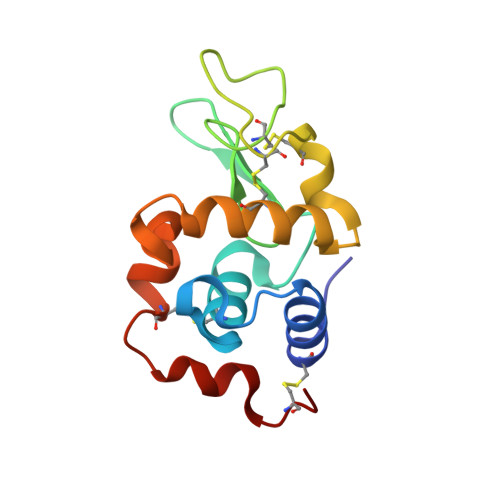The aroma of TEMED as an activation and stabilizing signal for the antibacterial enzyme HEWL.
Seraj, Z., Ahmadian, S., Groves, M.R., Seyedarabi, A.(2020) PLoS One 15: e0232953-e0232953
- PubMed: 32428017
- DOI: https://doi.org/10.1371/journal.pone.0232953
- Primary Citation of Related Structures:
6ABN, 6AD5, 6ADF, 6AEA - PubMed Abstract:
The unpleasant smell released from dead bodies, may serve as an alarm for avoiding certain behaviour or as feeding or oviposition attractants for animals. However, little is known about their effect on the structure and function of proteins. Previously, we reported that using the aroma form of TEMED (a diamine), representative of the "smell of death", could completely inhibit the fibril formation of HEWL, as an antibacterial enzyme, and a model protein for fibrillation studies. To take this further, in this study we investigated the kinetics of TEMED using a number of techniques and in particular X-ray crystallography to identify the binding site(s) of TEMED and search for hotspot(s) necessary to inhibit fibril formation of HEWL. Structural data, coupled with other experimental data reported in this study, revealed that TEMED completely inhibited fibril formation and stabilized the structure of HEWL through enhancement of the CH-Π interaction and binding to an inhibitor hotspot comprised of residues Lys33, Phe34, Glu35 and Asn37 of HEWL. Additionally, results from this study showed that the binding of TEMED increased the activity and thermal stability of HEWL, helping to improve the function of this antibacterial enzyme. In conclusion, the role of the "smell of death", as an important signal molecule affecting the activity and stability of HEWL was greatly highlighted, suggesting that aroma producing small molecules can be signals for structural and functional changes in proteins.
- Department of Biochemistry, Institute of Biochemistry and Biophysics, University of Tehran, Tehran, Iran.
Organizational Affiliation:





















